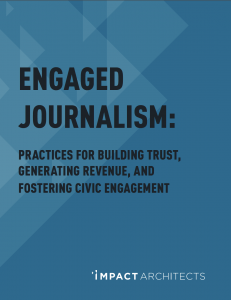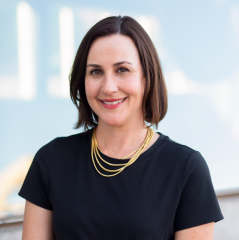Local news can lead in promoting engaged journalism

Engaged journalism is better when it also boosts community news fluency.
We founded the News Co/Lab with a project to help newsrooms increase transparency and engagement. Our work aims to put public service at the forefront of the news process — when that happens, improved journalism also improves community news fluency.
We didn’t aspire to pursue our mission alone. Instead, one of the first things we did was to identify and promote people and organizations that are trailblazers in engaged journalism, radical transparency and media literacy education. We then linked up with a number of forward-thinking partners to help us design newsroom experiments that put community news fluency at the center.
The journey has been rewarding and enlightening, and the lessons we’re learning continue to solidify for us the critical role journalists play in helping people better understand news. We’re excited that transparency and engagement are being recognized as integral to the journalism we need now and in the future.

- We were especially glad to see the recent report from Impact Architects: Connecting the dots: Engaged journalism, trust, revenue and civic engagement. Authors Lindsay Green-Barber and Eric Garcia McKinley conducted four case studies of media organizations practicing engaged journalism, including the McClatchy Company, one of the News Co/Lab’s founding partners. Results from the case studies offer evidence that engagement can increase trust, willingness to pay for news and create a more civically engaged audience. Green-Barber and Garcia McKinley recommend newsrooms identify measures of success before launching engagement projects, experiment in ways that attempt to connect engaged journalism with revenue and share best practices with others.
We are coming to similar conclusions as we wrap our pilot experiments with McClatchy partners in Fresno, Kansas City, and Macon, Georgia. Several of the projects are still in progress, but we wanted to share promising initial insights to add to the conversation.
But first, a bit about how we got started.
Impact Architects was right to suggest newsrooms think about measurement from the start. Because our mission is to improve community news fluency, we knew we needed to benchmark some key characteristics of our audiences. Working with the Center for Media Engagement at UT-Austin, we developed and conducted surveys with the public, news sources and newsrooms in our three partner communities.
We wanted to know more than what the public thinks about local news. We wanted to understand what people know about how journalism works. So we asked questions related to community perceptions of news in general and our local news partner specifically, their usage habits and we tested their media literacy skills. We asked the reporters how much they feel certain attributes of trust and credibility apply to their work.
We found that journalists rate themselves higher than news sources and the public for those attributes. But we also found opportunity for local news organizations to improve their relationships with the community — and help people become more news fluent. Survey results showed that, though there were many similarities in responses, the three newsrooms and communities have different needs, and would require tailored approaches best suited for each location.
Understanding where their communities are coming from, the newsrooms then designed experiments in transparency and engagement. Our plan is to survey everyone again this year to see if attitudes and skills have changed.
The community surveys are only one of the ways we are measuring our impact. As the Impact Architects report points out, there is no single metric that can tell us how engagement works. One reason for that is because the words “impact” and “success” can take on many different meanings. The News Co/Lab is also using feedback from events and the newsrooms’ standard engagement metrics to help evaluate our experiments.
We recently launched partner pages on our website to highlight the work we’re doing with each newsroom to increase transparency and community engagement.
Projects include:
In Fresno, we have helped shape the newsroom’s vision for radical transparency via features like “What’s Behind the Story?” and FAQs that answer questions about the reporting process. On the community engagement front, the Bee teamed up with dialogue journalism experts Spaceship Media to convene a group discussion around a geographic divide in the town. A follow-up survey of participants indicates a positive shift in perceptions of the Bee’s accuracy, credibility and trustworthiness.
In Kansas City, we helped forge a partnership between the public library, The Star and engagement tool Hearken to answer questions about the city’s past, present and future. Since launching in November 2018, the team has answered 14 reader questions. Each answer includes a detailed explanation of how they got they the information, to encourage readers to use the techniques to do their own research.
In Macon, we supported bringing Report for America reporter Samantha Max to the Telegraph to tackle the community’s questions about health. Samantha’s work regularly gets good visibility and spawns additional story ideas from readers. She has also engaged directly with the community via a Facebook group focused on community health. The News Co/Lab also sponsored a train-the-trainer news literacy session with the Center for News Literacy at Stony Brook University for Middle Georgia librarians. Participants will share what they learned in their own workshops.
The projects have had a positive impact on our newsrooms. Like Green-Barber suggests, “In the end, engaged journalism is just good journalism.” We believe it and our partners agree and are already planning to do more. We know it will take time and concerted effort to purposefully incorporate engaged journalism into newsroom routines. Research like Impact Architects and the recent report from Knight Commission on Trust, Media and Democracy helps validate our work and has us even more convinced that our mission is critical.
The challenges we face reimagining local news, fighting misinformation and building up community news fluency skills can seem insurmountable. But we will continue to champion transparency and engagement for newsrooms of all sizes and formats and be grateful to do it in good company.

Kristy Roschke, managing director of the ASU News Co/Lab, is a media scholar and educator. Her research interests include misinformation, media literacy education and media trust. Roschke has developed curriculum and taught journalism and media literacy courses at the high school and university level for nearly 20 years.
